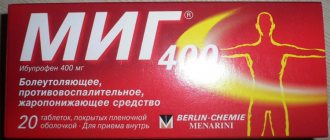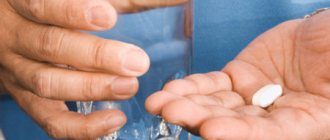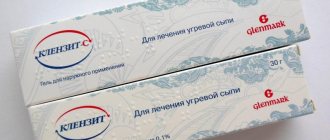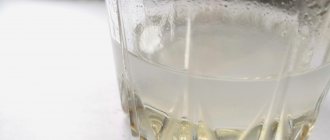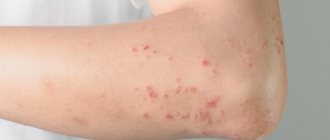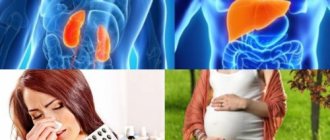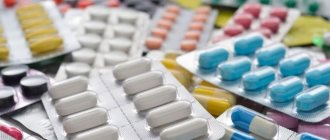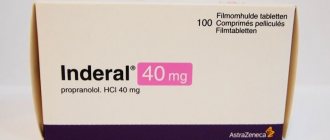Composition and release form
Sinekod is available in the following forms:
- Drops for oral administration (for children): transparent, colorless or colorless with a yellowish tint, with a vanilla odor (20 ml in dark glass bottles, one bottle in a cardboard box with a tamper evident system and a dropper dispenser);
- Syrup (vanilla): colorless, transparent, with a vanilla scent (100 ml or 200 ml in dark glass bottles, one bottle in a cardboard box complete with a measuring cap).
Composition of 1 ml drops for oral administration:
- Active ingredient: butamirate citrate – 5 mg;
- Auxiliary components: glycerol, 70% w/w sorbitol solution, benzoic acid, 96% ethanol, sodium saccharinate, 30% w/w sodium hydroxide, vanillin, water.
Composition of 1 ml syrup:
- Active ingredient: butamirate citrate – 1.5 mg;
- Auxiliary components: glycerol, 70% w/w sorbitol solution, benzoic acid, 96% ethanol, sodium saccharinate, 30% w/w sodium hydroxide, vanillin, water.
The medication is available in drip, tablet and syrup form. Pharmacies sell packages of 20, 100 or 200 ml or 10 tablets. The syrup comes with a measuring cap, the volume of which is equal to the daily dosage for an adult.
Sinekod for children, in particular for infants, is available in drop form. The active substance contained in the drug is butamirate citrate. It is a powerful antitussive component that can be seen in many expectorants. 1 ml of Sinecode contains 1.5 mg of active substance.
Auxiliary components:
- vanillin (used to give the preparation a mild taste and pleasant smell);
- sorbitol solution (moisturizes the throat, helps overcome dry cough);
- glycerol or glycerin (has a laxative effect and also normalizes intracranial pressure);
- benzoic acid (preservative);
- sodium hydroxide (lye);
- water.
Drops for children and Sinekod syrup differ in the ratio of components. In addition, the drop form of the drug contains a larger amount of active substance - 5 mg per 1 ml. One dragee (tablet) contains 50 mg of butamirate.
Pharmacological action of Sinekod
Sinekod is a direct-acting antitussive drug . The active ingredient is butamirate. The drug directly affects the cough center, blocking it, without depressing the respiratory center. It also has a bronchodilator and anti-inflammatory effect, correcting spirometry for the better.
After oral administration, the drug is rapidly absorbed by the gastrointestinal tract. The active substance butamirate is characterized by a high degree of binding to plasma protein. The concentration of the drug in the blood reaches its maximum after 1.5 hours. Sinecode is metabolized in the body, forming pharmacoactive metabolites. Repeated use of Sinekod does not change the pharmacokinetics. The half-life of the drug occurs within 6 hours. It is excreted mainly by the kidneys unchanged and as metabolites.
Which is better: drops or syrup?
The question of what is best to take arises in almost every patient. Naturally, if you use Sinekod for children, it is better to use the drop form, since it contains a smaller amount of ethyl alcohol. However, before giving the drug to a child under 2 years of age, you must consult with his or her doctor.
For adults, the form of the medicine is not important; they can take both syrup and drops. But it is worth understanding that Sinekod drops are intended for the treatment of children rather than adults.
People with various addictions should take into account the alcohol content of the medication and use it with caution. Patients suffering from alcoholism are recommended to use drops due to their lower alcohol content.
Applications and dosages
The dosage regimen for the drug in tablet form is determined individually. It is worth considering that the drug composition is not recommended for use by patients with liver and kidney problems. The medicine is not prescribed to elderly patients.
for adults
Dosages are determined privately depending on the indications for use of the drug.
for children
The drug in tablet form is not used in pediatric practice.
The drug is not recommended for use during pregnancy.
Indications for use
Sinekod is a syrup for children, reviews of which are mostly positive, and has the following indications for use:
- dry, debilitating, “barking” cough, not accompanied by sputum production, which is typical for bronchitis, tracheitis, and colds in the early stages;
- whooping cough;
- bronchial asthma;
- some methods for diagnosing the respiratory tract, associated with the need to introduce contrast (coloring) substances into them, in particular, bronchoscopy and bronchography;
- the need for surgical intervention;
- pre- and postoperative period, when coughing can cause sutures to diverge;
- cough caused by tobacco smoke entering the respiratory tract;
- cough, which is a symptom of heart or stomach disease.
Instructions for use
Each patient should read the instructions for use of Sinecode. The dosage for drops and syrup is different, which should also be taken into account before using the drug. It is not recommended to take the medicine with water; it should be taken before eating 3-4 times a day.
| Patient age | Applicable dosage for drops | Dosage for syrup | Number of appointments (per day) |
| From 2 to 12 months | 10 drops | 4 times | |
| From 12 months to 3 years | 15 drops | 4 times | |
| From 3 to 6 years | 25 drops | 5 ml | 4 times (drops), 3 times (syrup) |
| Children's age: from 6 to 12 years | 10 ml | 3 times | |
| Adolescence: 12 to 18 years old | 15 ml | 3 times | |
| Adult patients | 15 ml | 4 times |
Sinecode tablets should be taken 1-2 times a day. Daily dose: from 50 to 100 mg depending on the age of the patient. A smaller dosage is suitable for treating adolescents, a larger dosage is suitable for treating adults. Children should not be given jelly beans. The tablets are not chewed during use, but are swallowed whole and washed down with water.
Excessive dosage of Sinecod causes nausea, drowsiness, diarrhea, and increased blood pressure in children and adults. Some patients with an overdose experience vomiting and rash.
You can get rid of such symptoms by cleansing the body with activated carbon. You should not resort to laxatives, since Sinekod itself causes diarrhea.
Contraindications for Sinecode
Before using the medicine, it is important to read the instructions. This will avoid unfavorable results. The medication has certain limitations:
- pregnant women - first trimester;
- in case of individual immunity to any of the components of the drug;
- while breastfeeding;
- not appropriate age: drops up to 2 months, syrup up to 3 years, tablets up to 6 years.
- if you have allergies;
- if there is a history of pulmonary hemorrhage.
Side effects
List of adverse reactions:
- drowsiness;
- nausea;
- diarrhea;
- vomit.
In some cases, allergic reactions may occur. Cases of urticaria have been described.
Drug interactions of the active substance have not been described. Since the drug suppresses the cough reflex, you should avoid taking expectorants due to the risk of accumulation of mucous contents.
During the use of the drug Sinekod, the following side effects from systems and organs were observed (rare):
- Central nervous system: drowsiness, dizziness;
- Digestive system: diarrhea, nausea;
- Skin: exanthema;
- Other: allergic reactions.
There is no information on drug interactions with butamirate.
Side effects
The drug extremely rarely causes significant side effects. The use of the drug consistently provokes drowsiness, lethargy and diarrhea. But it is worth considering that absolutely all cough medications cause similar symptoms, since they contain sedative and laxative components.
Patients with allergies have a high likelihood of developing a rash and minor swelling on the face. If such symptoms are detected, you must stop using the medication.
Sinekod drops are safer to use because they contain less alcohol components. They can be used to treat adolescents with allergies.
Cinecode for children
Since the drug has a minimal number of adverse reactions and a minimal likelihood of complications, it is not classified as a narcotic antitussive and, therefore, is approved for children from an early age.
But if you do not follow the instructions, side reactions may occur in the form of swelling of the child’s larynx, which can cause breathing problems. Compared to other drugs, this phenomenon occurs quite rarely. Sinekod cannot be considered a completely harmless drug, but it is safer than other cough remedies.
Analogs
Sinekod for cough in drop form costs about 350 rubles, and in syrup form - 250 rubles. The exact price depends on the place of purchase and the nominal volume of the medicine. You can purchase the product in pharmacies and on the Internet.
The medication has analogues (medicines containing the same active substance):
- Codelac Neo (syrup, drops) - from 200 rubles.
- Omnitus (syrup, prohibited for children) - from 190 rubles.
- Panatus (syrup, prohibited for children) - from 250 rubles.
Sinekod can be stored for 3 years at a temperature not exceeding
The cough medicine Sinekod has a sufficient number of analogues that have a similar formula or have a similar mechanism of action. The patient must remember that the human body is individual in each specific case, therefore it is not recommended to use an analogue of the drug without consulting a specialist.
Omnitus
The drug Omnitus is considered as an antitussive drug with pronounced effectiveness. The composition is used for dry cough. It is worth considering that the use of the drug in tablet form is prohibited in pediatric practice. Children are prescribed the composition in syrup. Reception during pregnancy is strictly limited.
Codelac Neo
The drug Codelac Neo can be used to eliminate the urge to cough. It is worth considering that the medication is not a structural analogue of the cough medicine Sinecod, therefore it is not recommended to use Codelac as a substitute.
Stoptussin
The medicinal composition Stoptussin cannot be considered as a full-fledged analogue of the drug Sinekod. The composition has a similar mechanism of action, but has a different composition. The product is used in pediatrics as prescribed by a specialist.
The cost of Sinecode for cough is on average 259 rubles. Prices range from 191 to 415 rubles.
special instructions
Sinecode may cause drowsiness in the patient. This feature should be taken into account by patients whose professional activities involve driving vehicles and working with complex mechanisms.
It is prohibited to combine taking the product with drinking alcoholic beverages.
Sinekod drops and syrup contain saccharin and sorbitol as sweeteners, so the drug can be prescribed to patients with diabetes.
Since butamirate suppresses the cough effect, it is necessary to avoid the simultaneous use of expectorants with it. Otherwise, due to the accumulation of excess mucus in the respiratory tract, there is a high risk of developing bronchospasm and lower respiratory tract infection.
Due to the fact that Sinekod can cause drowsiness, after taking the drug you should exercise caution when driving or performing other work that requires concentration.
SINEKOD (syrup): reviews
Preface: For almost a whole month, the cough did not want to leave me, because the phlegm did not want to leave my body alone... More precisely, thanks to the means used, it (the cough) periodically disappeared, but since the means used somehow suppressed the cough (instead of remove phlegm and help the cough become moist and disappear on its own after cleansing the respiratory organs), the cough returned again after a while... What a “charm”, right? It is generally undesirable to suppress a cough, it helps rid the body of the excess that has accumulated in it and it is thanks to coughing that the lungs are cleansed... I actually know this and I have never tried to suppress it. For some reason they tried to suppress it with means that were claimed to remove sputum, to thin it out ...read more
niya and making it easier for her to come out. Oh yes, sometimes suppressing a cough is apparently necessary when necessary (for example, after operations and other cases when coughing can cause the stitches to come apart... well, stuff like that), but that was definitely not the case for me. Miraculously, the famous and advertised remedy (not cheap compared to others, by the way) suppressed this cough for me immediately after taking it, although it was promised to remove phlegm... then there were some other medicines that, for some reason, also did not want to make my life easier and sputum... but the cough disappeared (but I didn’t need this at all). But since what was supposed to be removed from the body still remained in it, the cough almost immediately after finishing taking the previous medications returned to me and became more and more severe. It was dry, it tore my throat, didn’t let me sleep, and generally tormented me in earnest. And all this trouble lasted almost a month (with interruptions), until I finally got my hands on “Sinekod”. By the way, folk remedies from childhood (such as heated milk with soda, heated milk with butter, milk with soda and iodine, and the like...) did not help at all. Except that the soda softened the throat and made coughing a little easier. But the phlegm did not want to appear and leave me; I felt a lump somewhere in my chest. By the way, I am very grateful to nature that she arranged it in such a way that despite the bullying of modern drugs and their attempts to suppress my cough, the body still sought to cleanse itself... no matter what. In general, NOVARTIS products most often made me happy and left me with the most pleasant impressions of use, almost all of those that I had the chance to try on myself. But first things first. What is it: The antitussive drug “Sinekod” (Butamirate 1.5 mg/ml) is a syrup. Colorless and transparent (there was still not enough dye to put in there... it would be a shame for Novartis, in my opinion). Not so viscous that it falls out of the bottle. It has decent fluidity, although not watery. The taste is stated to be vanilla... I can’t say that it frankly resembles vanilla. Moderately sweet, with a certain medicinal aftertaste (not particularly pleasant, but tolerable). In general, of course, “Sinekod” does not taste like a delicacy, but it is quite tolerable and does not cause disgust when taken. The bottle comes with a measuring container, making it easy to dose. Moreover, several options are indicated on the container; it is convenient to measure it for children too. EFFECTIVENESS: According to the instructions for "Sinekod" you need to drink 3 times a day before meals. The bottle runs out quite quickly (if used for an adult). It's a shame. Let me start with the fact that at the time of taking it, my cough was very dry and after all the episodes with expectorants (previous) drugs, the cough became more and more severe - it was not just dry, but also paroxysmal, with a whistle and generally coming from somewhere deep . Creepy. After the first dose of Sinekod, the cough became less painful and I felt that something was finally gurgling in the respiratory tract and would soon leave me (before that, the cough was just catastrophically dry, without signs of sputum and even without signs of its appearance in foreseeable future). After the second application, the sputum finally appeared, the cough became completely painless. I managed to fall asleep (on the first day of taking the drug) without incident. The next coughing attack awaited me only the next morning (on the first day of taking Sinekod, I only drank 2 caps, instead of the prescribed three) was already with normal phlegm, no pain at all, and in general my throat finally received relief and did not burst into parts. And in my chest, the disgusting feeling of a certain “stuffiness” and the feeling that there was a huge lump sitting there that didn’t want to fall in and didn’t want to come out began to disappear slowly. In short, it was happiness. I no longer hoped that any of the famous drugs would finally help me remove phlegm and not suppress my cough. By the way, “Sinekod” does not suppress it at all. This is surprising, because it is designed to suppress it and the drug has a direct effect on the cough center (as the manufacturer wrote) ... this is no less surprising, because the cough center is located in the head, as far as I know. In general, while others suppressed my cough, but it still returned, a lot of rubbish accumulated in my respiratory tract. Personally, I used Sinekod for almost a week (if memory serves) and during all these days of taking it, my cough was productive and did not stop prematurely. Until the body spat out everything it was supposed to, it calmed down. So I had to finish the entire bottle of “Sinekod” these days (and I also sometimes skipped a dose), it runs out quickly. Appearance of Sinekod syrup RESULTS: I did not observe any side effects throughout the entire period of use. In my opinion, the tool is wonderful. It also seems to help with whooping cough (in any case, I usually trust what is stated, it hasn’t deceived me yet, although in this case it surprised me). What is surprising, however, is that the antitussive drug “Sinekod” is designed (according to the instructions for the drug) to suppress cough and directly affect the cough center. But my cough was not suppressed at all; on the contrary, it became productive. Whereas the previous titled drug (intended to remove sputum) did not cope with its functions and, on the contrary, suppressed my cough, which only made the situation worse (the cough returned anyway, only it became even worse). fragment of instructions for the drug fragment of instructions for the drug; fragment of instructions for Sinekod syrup
Preface: For almost a whole month, the cough did not want to leave me, because the phlegm did not want to leave my body alone... More precisely, thanks to the means used, it (the cough) periodically disappeared, but since the means used somehow suppressed the cough (instead of remove phlegm and help the cough become moist and disappear on its own after cleansing the respiratory organs), the cough returned again after a while... What a “charm”, right? It is generally undesirable to suppress a cough, it helps rid the body of the excess that has accumulated in it and it is thanks to coughing that the lungs are cleansed... I actually know this and I have never tried to suppress it. For some reason they tried to suppress it with means that were stated specifically to remove phlegm, to dilute it and make it easier for it to come out. Oh yes, sometimes suppressing a cough is apparently necessary when necessary (for example, after operations and other cases when coughing can cause the stitches to come apart... well, stuff like that), but that was definitely not the case for me. Miraculously, the famous and advertised remedy (not cheap compared to others, by the way) suppressed this cough for me immediately after taking it, although it was promised to remove phlegm... then there were some other medicines that, for some reason, also did not want to make my life easier and sputum... but the cough disappeared (but I didn’t need this at all). But since what was supposed to be removed from the body still remained in it, the cough almost immediately after finishing taking the previous medications returned to me and became more and more severe. It was dry, it tore my throat, didn’t let me sleep, and generally tormented me in earnest. And all this trouble lasted almost a month (with interruptions), until I finally got my hands on “Sinekod”. By the way, folk remedies from childhood (such as heated milk with soda, heated milk with butter, milk with soda and iodine, and the like...) did not help at all. Except that the soda softened the throat and made coughing a little easier. But the phlegm did not want to appear and leave me; I felt a lump somewhere in my chest. By the way, I am very grateful to nature that she arranged it in such a way that despite the bullying of modern drugs and their attempts to suppress my cough, the body still sought to cleanse itself... no matter what. In general, NOVARTIS products most often made me happy and left me with the most pleasant impressions of use, almost all of those that I had the chance to try on myself. But first things first. What is it: The antitussive drug “Sinekod” (Butamirate 1.5 mg/ml) is a syrup. Colorless and transparent (there was still not enough dye to put in there... it would be a shame for Novartis, in my opinion). Not so viscous that it falls out of the bottle. It has decent fluidity, although not watery. The taste is stated to be vanilla... I can’t say that it frankly resembles vanilla. Moderately sweet, with a certain medicinal aftertaste (not particularly pleasant, but tolerable). In general, of course, “Sinekod” does not taste like a delicacy, but it is quite tolerable and does not cause disgust when taken. The bottle comes with a measuring container, making it easy to dose. Moreover, several options are indicated on the container; it is convenient to measure it for children too. EFFECTIVENESS: According to the instructions for "Sinekod" you need to drink 3 times a day before meals. The bottle runs out quite quickly (if used for an adult). It's a shame. Let me start with the fact that at the time of taking it, my cough was very dry and after all the episodes with expectorants (previous) drugs, the cough became more and more severe - it was not just dry, but also paroxysmal, with a whistle and generally coming from somewhere deep . Creepy. After the first dose of Sinekod, the cough became less painful and I felt that something was finally gurgling in the respiratory tract and would soon leave me (before that, the cough was just catastrophically dry, without signs of sputum and even without signs of its appearance in foreseeable future). After the second application, the sputum finally appeared, the cough became completely painless. I managed to fall asleep (on the first day of taking the drug) without incident. The next coughing attack awaited me only the next morning (on the first day of taking Sinekod, I only drank 2 caps, instead of the prescribed three) was already with normal phlegm, no pain at all, and in general my throat finally received relief and did not burst into parts. And in my chest, the disgusting feeling of a certain “stuffiness” and the feeling that there was a huge lump sitting there that didn’t want to fall in and didn’t want to come out began to disappear slowly. In short, it was happiness. I no longer hoped that any of the famous drugs would finally help me remove phlegm and not suppress my cough. By the way, “Sinekod” does not suppress it at all. This is surprising, because it is designed to suppress it and the drug has a direct effect on the cough center (as the manufacturer wrote) ... this is no less surprising, because the cough center is located in the head, as far as I know. In general, while others suppressed my cough, but it still returned, a lot of rubbish accumulated in my respiratory tract. Personally, I used Sinekod for almost a week (if memory serves) and during all these days of taking it, my cough was productive and did not stop prematurely. Until the body spat out everything it was supposed to, it calmed down. So I had to finish the entire bottle of “Sinekod” these days (and I also sometimes skipped a dose), it runs out quickly. Appearance of Sinekod syrup RESULTS: I did not observe any side effects throughout the entire period of use. In my opinion, the tool is wonderful. It also seems to help with whooping cough (in any case, I usually trust what is stated, it hasn’t deceived me yet, although in this case it surprised me). What is surprising, however, is that the antitussive drug “Sinekod” is designed (according to the instructions for the drug) to suppress cough and directly affect the cough center. But my cough was not suppressed at all; on the contrary, it became productive. Whereas the previous titled drug (intended to remove sputum) did not cope with its functions and, on the contrary, suppressed my cough, which only made the situation worse (the cough returned anyway, only it became even worse). fragment of instructions for the drug fragment of instructions for the drug; fragment of instructions for Sinekod syrup
Rating: 5 5
Source:
irecommend.ru
Benefits of the medication
The main advantage of Sinecode is its relatively safe composition. Despite this, the drug acts quickly and is not inferior in effect to medications containing narcotic components.
The medicine Sinekod can be given to a child without fear that the effect of the medication will negatively affect the child’s body. The drug has been tested on animals more than once, and absolutely all studies have given positive results.
The medication expands the lumen of the bronchi, saturates the blood with oxygen and completely eliminates cough. This product is one of the most effective in its category. Many pediatricians include it in course treatment for patients with ARVI and influenza.
Sinekod syrup, pregnancy and lactation - how not to harm the baby
Even doctors cannot say with certainty how safe the drug is during pregnancy or while breastfeeding. Clinical studies have not been conducted, so only a doctor can prescribe syrup to a pregnant woman. The only thing that has been determined with certainty is that when testing the product on animals, no manifestations were noticed, so Sinekod can be considered conditionally safe.
It is not recommended to take the drug during the first trimester of pregnancy, since it is during this period that there is a risk of harm to the fetus. In subsequent trimesters, the drug can be taken, but only if absolutely necessary, if the doctor considers that the benefit to the mother outweighs the possible risk to the fetus.
It is unknown how the components of the drug affect the child’s body during lactation, therefore it is forbidden to combine breastfeeding and treatment with Sinekod. If there is a need for treatment with the drug, doctors recommend stopping feeding the baby for this time, and resuming the process after complete recovery and completion of the course of taking the syrup. Its effect stops 12 hours after the last use.



